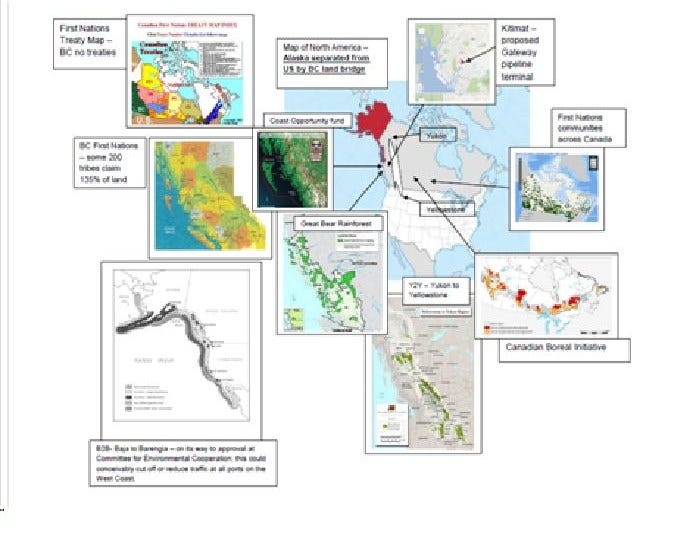The Great Eco-Wall of Canada
In support of MLA Dallas Brodie's comments in the BC Legislature today May 01, 2025
By Michelle Stirling © 2013 & 2025
I first wrote this in 2013, but the content pertains to what Dallas Brodie was asking about in the BC Legislature today; in return for her questions and concerns, Premier David Eby just called her names. Her concerns today are as valid as mine were over a decade ago. Update: Here is the tweet of Dallas Brodie’s as some followers were asking what Eby said. My original commentary from 2013 follows below that tweet screenshot.
The “Idle No More” protests have surprised most Canadians. The roots of it lie in opportunistic partnerships between environmental activists and First Nations, promoted by the International Funders for Indigenous People’s (IFIP) located on Mohawk territories in Akwesasne.
This document can be found on this page. Scroll down.
The May 16, 2010 IFIP session of the 9th annual conference in Tofino details successes in “Fighting Alberta’s Tar Sands: A Cross-ENGO Cross-First Nations Collaboration” and was facilitated by Michael Marx of the Tar Sands Fund and Tides Foundation.
“Fighting Alberta’s Tar Sands” reveals how the Cooperative Bank of the UK, together with the WWF and BankTrack are combining international forces to decimate the oil sands’ social license to operate. “According to Marx, the campaign’s ‘big goal’ is to end expansion of the oil sands. Key to that, he said, is blocking approval of a $7 billion pipeline under review by the US Department of State.” (Keystone)
Canada has an uneven mix of land agreements with First Nations. In B.C. there are virtually no treaty arrangements with the more than 200 distinct First Nations who together claim 135% of the territory (pg 60).
This gap in title rights was useful in a joint forestry battle from which the multi-million dollar Coast Opportunity Fund for First Nations arose. Eco-activists used coercive techniques on the logging industry, publicly shaming them in the New York Times. “Next, the First Nations started suing businesses and the government. There was so much conflict that change had to happen or no one could go forward.”(pg 61)
That Coast Opportunity Fund encompasses all the tribes and coastal inlets from Alaska almost down to Vancouver. Overlapping much of this is Great Bear Rain Forest.
Alaska is only separated from the US by a land bridge called B.C. This area is now part of a major environmental-First Nations initiative. It is called “Y2Y” – Yellowstone to Yukon – intended to be a vast nature conservancy passing from Alaska to the US.
Even to the west of the Rockies the Canadian Boreal Initiative forms a similar no-go eco-zone to west-east development.
Thus we are faced with invisible walls of untouchable territory and the threat of volatile conflict and vicious international campaigns to dishonour industry.
An even more ambitious plan – the B2B – Baja to Barengia – could shutter all West Coast ports. This plan is on its way to acceptance in the Commission for Environmental Cooperation.
First Nations and eco-activist initiatives count on broad support from the NGO/charitable sector – which now outnumbers producers.
As TIDES’ CEO Ross McMillan recently told the Economic Club of Canada: “The charitable and not-for-profit sector employs more than 2 million people, representing about 11 percent of the country’s workforce. By way of comparison, this sector employs four times as many people in Canada as the oil and gas sector and five times that of the automotive industry.”
Alberta’s resource industries drive at least 30% of the Canadian economy. Yet Alberta’s oil sands products export routes are blocked by protests: anti-Gateway to the west, anti-Keystone to the south and pro-Boreal to the east.
My apologies for the poor quality images - made years ago with low quality technology - but you get the drift. It’s an eco-wall.
At least one coastal First Nation is claiming the ocean as theirs.
Old Massett Village is a Haida community in the Coast Opportunity region that recently financed geoengineer Russ George for $2.5 Million through the Haida Salmon Restoration Corp. to dump 120 million metric tons of iron sulphate in the ocean without appropriate federal or international permits. George hoped to stimulate a plankton bloom and intends to make money off carbon offsets if this idea works. The Haida hope it will stimulate salmon growth for their fish industry.
It is surprising that a village of some 2,586 people with 70 percent unemployment could find $2.5 million for a carbon sequestration project (though a recent article on rabble.ca suggests carbon trade, not nature conservation, was the main purpose of establishing the Great Bear Rainforest).
Yet one wonders at the expertise of the Haida for ocean experiments and why federal approvals were not sought.
“This is the Haida Ocean….”claims Russ George in an interview in the Oct. 24, 2012 issue of Scientific American.
The deepwater port of Prince Rupert and proposed Gateway port of Kitimat are here in the ‘Haida Ocean’, a region most Canadians and international investors believe to be ‘our’ ocean.
First Nations and ENGOs successfully used conflict to get what they want. Major offshore foundations have underwritten them, either keen for carbon trades or locked-in resources at rock-bottom prices.
It’s a green velvet territorial conquest of Canada.
– 30 –









what did Eby call Brodie? what was the topic?